#rs232 connector
Explore tagged Tumblr posts
Text
https://www.futureelectronics.com/p/semiconductors--signal-interface--rs-232/icl3221eivz-t-renesas-9034756
RS 232 cable, RS 232 voltage, Wireless USB, rs232 cable types
ICL3221 Series 250 kbps 15 kV RS232 5.5V Transmitter/Receiver - TSSOP-16
#Signal Interface#RS 232#ICL3221EIVZ-T#Renesas#communication#rs232 connector#RS 232 USB#RS 232 cable#RS 232 voltage#Wireless USB#rs232 cable types#RS 232 cable to USB#USB Full Speed#USB serial controller d driver
1 note
·
View note
Text
Sharing a Computer with More Friends
A few months ago I built an I/O expansion board for my homebrew 68030 project with a 4-port serial card to go with it, and got BASIC running for four simultaneous users. It worked, but not as well as I had hoped. I wanted to be able to run two of those serial cards to support 8 total users, but it had proven unstable enough that with just the one card I had to slow down the whole system to 8MHz.
So I designed a new serial card.

I had previously been running this computer without any issues at 32MHz with a mezzanine card with FPU & IDE as well as a video card. The main board by itself can clear 56MHz. Having to go all the way down to 8MHz just didn't sit well with me. I want this machine to run as fast as possible for its 8 users.
I put extra time into reviewing worst-case timing for all components and graphing out how signals would propagate. The 16C554 quad UARTs I'm designing around are modern parts that can handle pretty fast bus speeds themselves — easily up to 50MHz with no wait states on the 68030 bus — assuming all the glue logic can get out of the way fast enough.
Signal propagation delays add up quickly.
My first draft schematic used discrete 74-series logic for chip selection, signal decoding, timing, etc. At slower bus speeds this wouldn't have been a problem. But I want this thing to run as fast as possible. By the time critical signals had made it through all those logic gates, I was looking at already being well into one wait state by the time the UART would see a 50MHz bus cycle begin.
I needed something faster. I was also running low on space on the board for all the components I needed. The obvious answer was programmable logic. I settled on the ATF22V10 as a good compromise of speed, size, availability, and programmability. It's available in DIP with gate delays down to 7ns. Where discrete gates were necessary, I selected the fastest parts I could. The final design I came up with showed a worst case timing that would only need one wait state at 50MHz and none for anything slower.
It ended up being a tight fit, but I was able to make it work on a 4-layer board within the same footprint of my main board, putting some components on the back side. (It may look like a bunch of empty space, but there's actually a lot going on running full RS232 with handshaking for 8 ports).
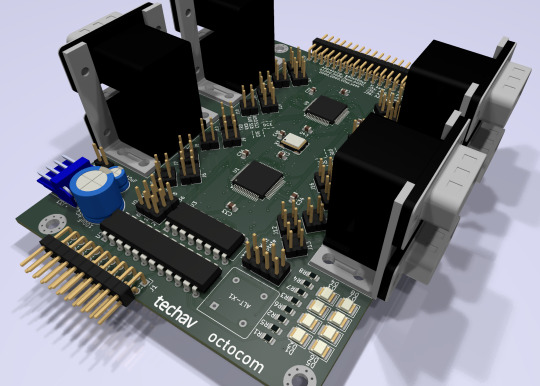
New problem. I had blown my budget for the project. As much as I love those stacked DE9 connectors, they're expensive. And there's no getting around the $10 pricetag for each of those quad UARTs. Even using parts on-hand where possible, I was looking at a hefty Mouser order.
[jbevren] suggested using ganged RJ45 connectors with the Cisco pinout instead of stacked DE9, to save space & cut costs. [Chartreuse] suggested buffering the TTL serial TX/RX signals to drive the LEDs that are frequently included on PCB-mount RJ45 connectors. Both great ideas. I was able to cut 20% off my parts order and add some nice diagnostic lights to the design.
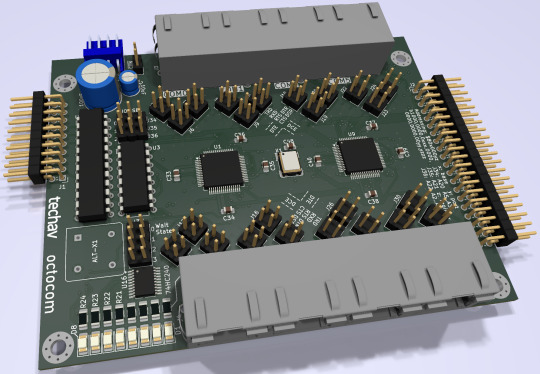
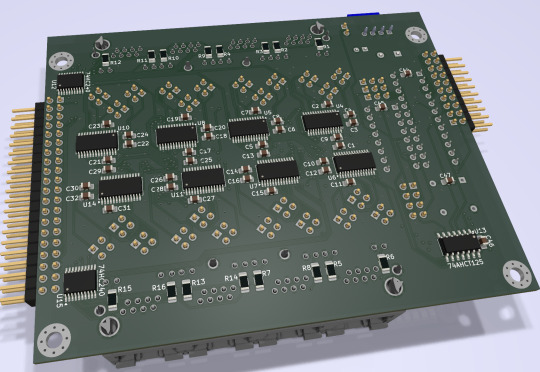
Two weeks later, I received five new PCBs straight from China. I of course wasted no time setting into starting to assemble one.
I really set myself up for a challenge on this one. I learned to solder some 25 years ago and have done countless projects in that time. But I think this might be the most compact, most heavily populated, most surface mount board I've ever assembled myself. (There are 56 size 0805 (that's 2x1.2mm) capacitors alone!)


After a few hours soldering, I had enough assembled to test the first serial port. If the first port worked then the other three on that chip should work too, and there's a great chance the other chip would work as well.

And it did work! After some poking around with the oscilloscope to make sure nothing was amiss, I started up the computer and it ran just fine at 8MHz.
And at 16MHz.
And at 25MHz.
And at 32MHz.
And at 40MHz.
And almost at 50MHz!
Remember what I said about my timing graphs showing one wait state for 50MHz? The computer actually booted up and ran just fine at 50MHz. The problem was when I tried typing in a BASIC program certain letters were getting switched around, and try as I might, BASIC just refused to 'RQN' my program. It was pretty consistently losing bit 3, likely from that signal having to travel just a tiny bit farther than the others. A problem that will probably be resolved with an extra wait state.
Good enough for a first test! A few hours more and I finished assembling the card.

I did have some problems with cleaning up flux off the board, and I had to touch up a few weak solder joints, but so far everything seems to be working. I've updated my little multi-user kernel to run all 8 users from this new card and it's running stable at 40MHz.
I need to update my logic on the 22V10 to fix a bug in the wait state generator. I would love to see this thing actually running at 50MHz — a 25% overclock for the 40MHz CPU I am currently running. I also want to expand my little kernel program to add some new features like the ability to configure the console serial ports and maybe even load programs from disk.
I hope to bring this machine with a collection of terminals and modems this June to VCF Southwest 2025 for an interactive exhibit that can be dialed into from other exhibits at the show.
#wrap030#multi-user BASIC#EhBASIC#homebrew computer#motorola 68030#68030#mc68030#motorola 68k#vcfsw#vcfsw2025#Retrocomputing#rtc#retrotech crew
31 notes
·
View notes
Text
DB9: The Little Prince of Ports
On Asteroid Tech-612, where copper vines twist like baobabs and circuits glow like stars, there lives a small connector with nine golden pins—the DB9. Though newer ports boast flashy speeds, this humble traveler guards factories and hospitals with the quiet wisdom of the Little Prince. Let’s wander the cosmos to learn why galaxies still whisper its name.

1. The Prince’s Humble Asteroid
The DB9 thrives where others fear to tread:
Volcanic Factories: Welding sparks fly like comets, yet its pins grip tighter than the lamplighter’s devotion.
Ice-Cold Hospitals: -40°C MRI rooms? “What matters is invisible to the eye,” it muses, steady as a heartbeat monitor.
Dusty Aviation Hangars: Guides planes through storms, unbothered by lightning’s tantrums.
Why USB-C’s planet fails:
“Too busy counting pins to see the stars.”
2. Journey Through the Planets
Planet of the Welding Robot: “Why do you spark so much?” asked the Prince. “To forge constellations,” DB9 replied, its RS232 voice cutting through EMI like a fox’s whisper.
Planet of the Retro Gamer: Between pixelated explosions, DB9 sighed: “Grown-ups rush; my N64 savors every frame.”
Planet of the Grumpy Engineer: Thumbscrews locked like secrets. “USB snaps. I endure,” said DB9, polishing oxidation off pin 5.

3. The Fox’s Secret
“Tame me,” begged the EMI interference. DB9 shook its head: “My shield is simpler: ±15V logic and a grounded heart.”
4. The Businessman’s USB-C Empire
“I have 24 pins!” boasted USB-C, drowning in dongles. DB9 watched a CNC machine carve roses: “Your speed is fleeting. My 1,000+ insertions? Eternal.”
5. Where Roses Still Bloom
Industrial Deserts: DB9 outlives touchscreens in forklifts, smiling as sparks dance like fireflies.
Medical Oases: EKG machines cling to its pins—steady as the Prince’s rose under glass.
Retro Gardens: Where GoldenEye 007 never dies, and USB adapters wilt like plastic baobabs.
Epilogue: The Connector’s Cosmos As rockets chase thinner ports, Asteroid Tech-612 glows gold. For what is essential—endurance, simplicity, a thumb-screw’s embrace—no algorithm can replace.
1 note
·
View note
Text
RS232 is serial porting: But not all serial ports are RS232
0 notes
Photo
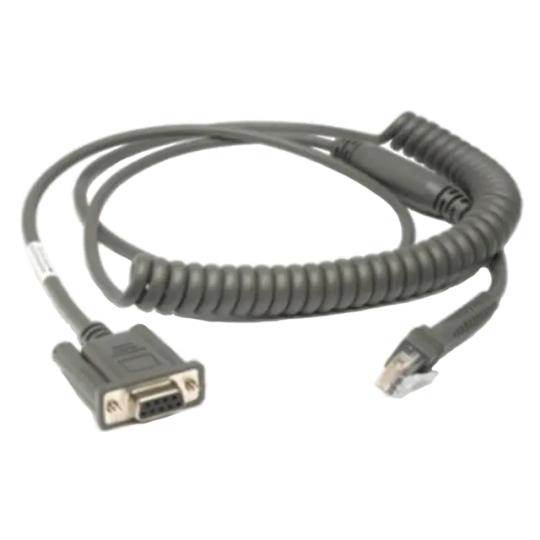
Zebra Serial 2.8m Cable Specifications: 2.8m RS232/DB9 Female Connector Coiled Power Pin 9 TxD on 2 True Converter
0 notes
Text
Price: [price_with_discount] (as of [price_update_date] - Details) [ad_1] Feature: 1. USB Full Speed Port: INLINE 6 can communicate with your PC via 9pin serial connector. Communication with your PC is also possible via Universal Serial Bus (USB) via a 4pin standard connector. 2. Data Link: The INLINE 6 adapter connects to the vehicle power supply, SAE J1708/J1587 data link, and two CAN/J1939 data links via a 25pin serial connector. 3. RP1210 Standard: INLINE 6 will work for INSITE, for PowerSpec and for Calterm III software applications. Can also be used with any other software application that is fully RP1210 compliant. 4. Easy Use: Each INLINE kit contains a data link adapter, basic cable and INLINE PC software driver. Load the software drivers, connect all the hardware, and you're ready to start a of data link adapters. 5. Long Durability: Attractive black powder coated aluminum housing provides sturdiness. Rated operating temperature from ‑40°C to +85°C meets stringent cab environmental testing requirements. Specification: Item Type: Inline 6 Data Link Adapter Kit Material: ABS, Aluminum Features: 1. Supports SAE J1708/J1587 and J1939/CAN data links 2. Both CAN ports auto detect between 250 and 500 kbps 3. Supports USB full speed port at up to 2Mrate 4. USB cable includes thumbscrews for secure mounting to INLINE 6 5. Supports RS 232 PC serial port at up to 115.2krate 6. Fully compliant with TMC's RP1210 standard 7. Small enough to fit in pocket 8. Attractive black powder coated aluminum housing provides ruggedness 9. Derives 8 V to 50 V DC power from vehicle 10. Controlled by advanced 140 MHz 32bit for processor for maximum speed and performance 11. Includes 6 LEDs to indicate status of power, USB, RS232, J1708/J1587, and two CAN communication ports 12. Both CAN ports support SAE J1939, SAE J2534, and ISO 15765 protocols 13. INLINE 6 is certified to meet European CE requirements 14. Rated for -40°C to + 85°C operating temperature 15 New in Box 100% Brand New Good Quality Durable and Eco Friendly Material. Package Contain Pack Of 1 Item. In case of any query please contact seller. [ad_2]
0 notes
Text
King of TV Boxes for 2024 ZIDOO Z9X 8K Amlogic S928X-K

ZIDOO Z9X 8K TV Box: A Game-Changer in the Android TV Box Market
What is the Zidoo Z9X 8K Android media player? Every so often, an Android box emerges reason the bar to a whole new level, adding a new features and changing the way we use Android boxes. One such model is the 2024 Zidoo Z9X 8K. Today, I'm diving deep into this brand-new contender in the Android TV box market. While we've all heard of big names like Nvidia Shield, UGOOS, and Beelink, these brands have dominated the high-performance Android TV box scene for years. But today, the ZIDOO Z9X 8K TV Box is a game-changer, offering features no other Android box currently delivers. https://youtu.be/tlFNA7Yg8D0 The New King of 2024 We’ve already seen some great Android TV boxes this year. The UGOOS SK1, for example, has been my top pick so far. It’s a powerful box with impressive features. But just when I thought 2024 couldn’t get any better, Zidoo released the Z9X 8K TV Box. This model came out of nowhere, and it’s quickly making waves in the Android TV box community. So, is the ZIDOO Z9X 8K TV Box the new king of Android boxes for 2024? Let’s find out.

Unboxing the ZIDOO Z9X 8K TV Box Let’s start with what’s inside the box. The ZIDOO Z9X 8K TV Box package includes all the essentials. But, there are a few surprises too. Here’s what you get: - The Z9X 8K TV Box itself - A Zidoo V11 infrared remote, complete with IR learning capabilities - A high-quality HDMI cable - A SATA cable for connecting external hard drives and SSDs - A 12V 2A 24W DC power supply - A manual for the remote - A warranty card and a QuickStart guide It’s a standard package, but the inclusion of the SATA cable is a nice touch. This shows Zidoo’s commitment to providing a comprehensive experience right out of the box.

Design and Build Quality Zidoo has stuck to its roots with the design of the Z9X 8K TV Box. It features a sturdy aluminum body, which not only looks premium but also helps with heat dissipation. The surface of the box proudly displays all its premium features, including 8K resolution, HDR10+, DTS audio, Dolby Vision, and Dolby Audio.

Connectivity Options When it comes to connectivity, the ZIDOO Z9X 8K TV Box doesn’t disappoint. It’s packed with ports and options to connect all your peripherals. Here’s what you’ll find: - At the back: - One HDMI 2.1 port - One gigabit LAN port - A reset button - One USB 3.0 port - One 3.5mm audio output socket - One optical audio port - An on/off switch - Two WIFI6 antennas - On the left side: - Two USB 3.0 ports - A SATA connector for external hard drives and SSDs - On the right side: - Two USB 2.0 ports - An RS232 connector - At the front: - An LED display The base of the box features four anti-skid rubber feet and plenty of ventilation holes to keep things cool.




ZIDOO Z9X 8K Cutting Edge ZIUI interface Zidoo is one of the few manufacturers that design their own user interface. The ZIDOO Z9X 8K TV Box features the ZIUI Cancer interface. This latest version includes a horizontal bar for main icons that can’t be changed, but you can add shortcuts below it. The top section includes a date and time widget, as well as a weather widget. You can also change the wallpaper, although it only applies to certain sections of the interface. The ZIUI Cancer interface is built on Android TV OS, so it lacks a navigation bar or status bar. However, it’s designed to be user-friendly with a directional pad and an okay button.

Firmware and Updates Here’s an important note for anyone getting the ZIDOO Z9X 8K TV Box: When you first connect to the internet, you’ll be prompted to update the firmware. The default firmware doesn’t include the Google Play Store or Play Services. But don’t worry! Zidoo offers a G-version firmware that includes the Google Play Store. You can download it from their website and update via USB. Once updated, you’ll have full access to the Google Play Store and Google Play Services.
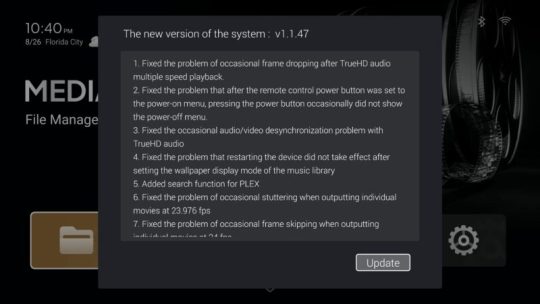
Unique Firmware Features Zidoo’s ZIUI interface is packed with unique features. Let’s take a closer look at some of the key settings:

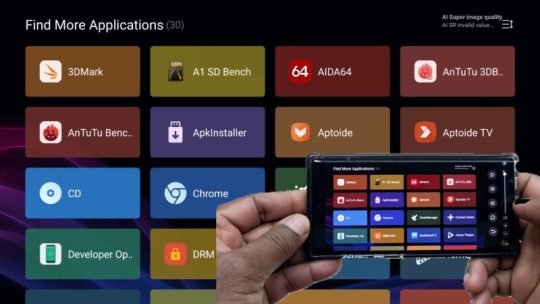
Playback Settings The playback menu is all about optimizing your viewing experience. You can enable auto framerate switching, set bookmarks, and configure subtitle and audio settings. There’s even a digital signage mode that lets you set a video playlist to start playing automatically when the box is turned on.
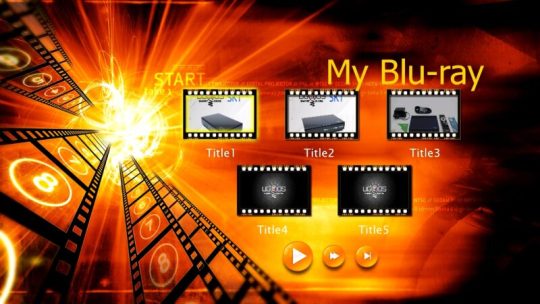
Display Settings The ZIDOO Z9X 8K TV Box supports up to 8K resolution. However, since I don’t have an 8K TV, I could only test up to 4K. The box also offers advanced AI image and video upscaling, which enhances the display quality of connected devices like Blu-ray players. You can adjust the upscaling level and even display an overlay to see the current settings.

Audio Settings The audio settings are just as impressive. Furthermore, you can choose your audio source, enable downmixing, and configure audio passthrough. In addition, the ZIDOO Z9X 8K TV Box even supports DSD audio format, which is notoriously difficult to play. If your receiver supports DSD, then you’re in for a treat.
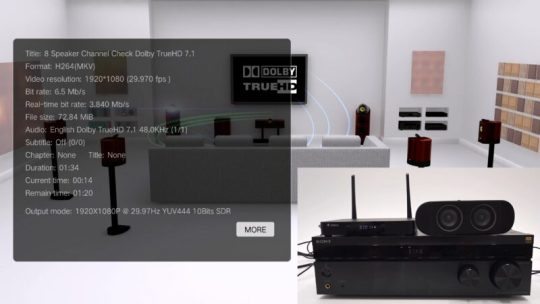

Network Settings The ZIDOO Z9X 8K TV Box has robust network settings. You can configure Wi-Fi, Ethernet, Bluetooth, and even set up a SAMBA server. There’s also an option to use the box as a Wi-Fi hotspot.


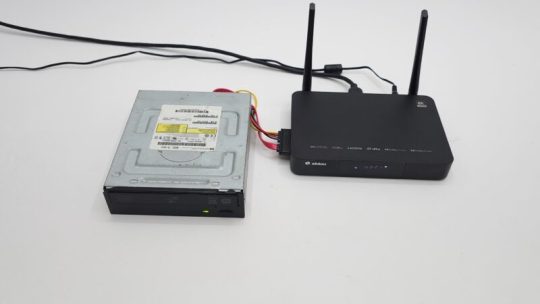
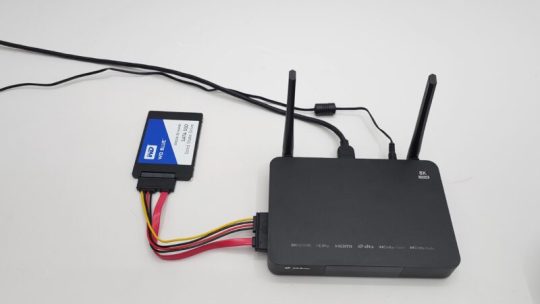
Other Settings Under the “Other” menu, you can change the language, configure HDMI CEC, set power options, and more. You can also enable developer options and access legacy Android settings. However, screen rotation and a root switch are missing. Zidoo does provide root access through their special app called One Key Root, although it’s not available for the Z9X 8K model.

ZIDOO Z9X 8K Specs Now, let's talk about performance. The ZIDOO Z9X 8K TV Box is powered by an Amlogic S928X-K penta-core processor. Moreover, it has 6GB of DDR4 RAM and 64GB of internal storage. In addition, the GPU is a Mali G57 MC2, which supports OpenGL ES 3.2 and Vulkan API 1.1. Furthermore, it is equipped with Wi-Fi 6 and runs on Android 11.


Movie Streaming and DRM The ZIDOO Z9X 8K TV Box has Google Widevine Level 1 DRM and HDCP 2.3 protection. While it doesn’t have an official Netflix ESN license, you can still watch Netflix in 1080p with a modified app. The box’s AI upscaling feature can enhance the resolution, making your content look even better.


Gaming and App Compatibility When it comes to gaming, the Play Store on the ZIDOO Z9X 8K TV Box is limited. You can sideload games, but not all of them are compatible. The box handles high graphics settings well without overheating, but Zidoo needs to update the Google Play Store and Play Services for a better gaming experience.

Benchmark Scores Here are the benchmark results for the ZIDOO Z9X 8K TV Box: - RAM Speed: 17,149 MB/s - Internal Storage Speed: 158 MB/s read, 149 MB/s write - Wi-Fi and Ethernet Performance: Maxed out at 315 Mbps on 5GHz and gigabit Ethernet, and 199 Mbps on 2.4GHz - Geekbench 5 CPU Score: 409 single-core, 754 multi-core - 3DMark Wildlife GPU Score: 980, with an average FPS of 5.90 - Antutu Benchmark Score: 286,912 These results put the ZIDOO Z9X 8K TV Box at position 7 on my rankings chart, just below the UGOOS SK1 and AM8.

Final Thoughts The ZIDOO Z9X 8K TV Box is a serious contender in the Android TV box market. With its impressive features, solid performance, and unique firmware options, it’s definitely a top choice for 2024. While there are a few areas where it could improve—like gaming compatibility and the inclusion of Google Play Services—there’s no denying that the ZIDOO Z9X 8K TV Box is a game-changer.

If you're seeking a high-performance Android TV box capable of handling demanding tasks like 8K video playback and advanced audio formats, the ZIDOO Z9X 8K TV Box is an excellent choice. Its impressive array of features sets it apart from other options on the market, making it a leading candidate for the title of best Android TV box of 2024. Read the full article
#2024ZidooZ9X8Kreview#ZidooZ9X8KAmlogicS928X-K#ZidooZ9X8Kbenchmarks#ZidooZ9X8KDolbyAtmosDTSaudio#ZidooZ9X8KDolbyVision#ZidooZ9X8Kfirmware#ZidooZ9X8Khardwarespecs#ZidooZ9X8KNetflixinHD#ZidooZ9X8Kpenta-core#ZidooZ9X8Kperformance#ZidooZ9X8Kprice#ZidooZ9X8Kprosandcons#ZidooZ9X8Krooted#ZidooZ9X8KTVBox#ZidooZ9X8KTVBoxStop
0 notes
Text
Buy HC05 Bluetooth Module at Affordable Price in Ainow
HC05 Bluetooth Module
The Bluetooth Transceiver HC05 bluetooth Module with enable/disable button Breakout is the latest Bluetooth wireless serial cable! This version of the popular Bluetooth uses the HC05 module. These modems work as a serial (RX/TX) pipe. Any serial stream from 9600 to 115200bps can be passed seamlessly from your computer to your target. The remote unit can be powered from 3.3V up to 6V for easy battery attachment. All signal pins on the remote unit are 3V-6V tolerant. No level shifting is required. Do not attach this device directly to a serial port. You will need an RS232 to TTL converter circuit or Arduino XBee USB Adapter if you need to attach this to a computer. You can either solder a 6-pin header or individual wires. The unit comes without a connector. Please see related male and female pins below. And now, we provide HC-05/06, HC05 bluetooth module could be set to Master or Slave by a user. HC-06 just be Master or Slave, that could be customized.
HC05 bluetooth module Applications:
Embedded Projects
Industrial Applications
Computer and portable Devices
GPS receiver.etc.
Note: Product Image may vary in terms of design and colour of the board
Features :
CSR Bluetooth Chip Solution-Bluetooth Spec v2.0 EDR Compliant
Enhanced Data Rate (EDR) compliant with V2.0.E.2 of the specification for both 2Mbps and 3Mbps modulation modes
Full Speed Bluetooth Operation with Full Piconet Support and Scatternet Support
Incredible small size with 3.3V input, and RoHS Compliant-UART interface and with baud rate setup function
Support for 8Mbit External Flash Onboard Support for 802.11Co-Existence. A range of operation: 8 – 10 meter.

0 notes
Text
MxN MEMS Matrix Optical Switch
Fiber type: SM, MM, PM, Hi1060, etc.
Wavelength: 850/1310/1550nm,etc
Connector: FC/LC/SC, etc.
Control: TTL/RS232/RJ45
Special optical fibers and special wavelengths can be customized.
Read more https://www.xhphotoelectric.com/en/products/
E-mail: [email protected]

#xhphotoelectric#mems optical switch#matrix optical switch#mechanical optical switch#optical switch#mxn optical switch#photonics#optics#1xn optical switch#fiberoptic
0 notes
Text
Siemens 6GK5980-3BC00-0AA5 Serial cable
Siemens 6GK5980-3BC00-0AA5 Serial cable M12/RS232; Pre-assembled serial cable with M12 and RS232 connector; Length 3 m; 1 pack = 1 unit. Model: 6GK5980-3BC00-0AA5Categories: Industrial EthernetBrand: SiemensSiemens 6GK59803BC000AA5 Serial cableSiemens 6GK5980-3BC00-0AA5 Serial cable 100% New & Original. Quick Quote. Fast Delivery. Competitive Price. One year Warranty.Buy Siemens Industrial…
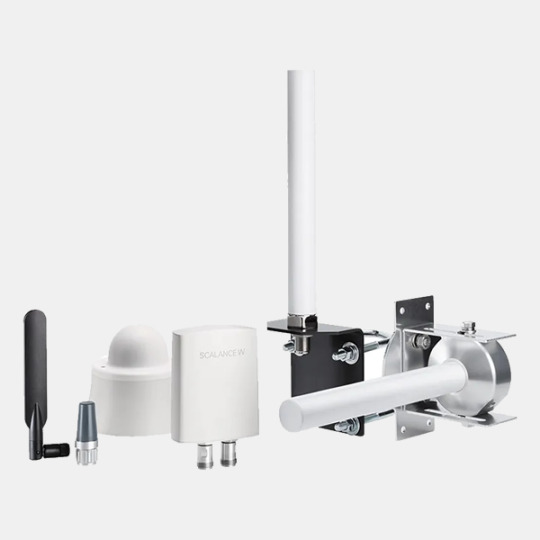
View On WordPress
0 notes
Text
In the Beginning: The History and Evolution of Device Servers

Lantronix PremierWave EN dual band WiFi device server
In the beginning (well the 1980s), there were terminal servers. And they were good. These devices allowed for dozens of ‘dumb’ terminals to be connected to a mainframe or minicomputer over a single wired Ethernet connection. They were widely deployed at banks, automotive dealerships and insurance companies - anywhere a concentration of computer users was to be found. One of the main benefits was not having to run yet another cable all the way from the main computer to the new terminal location. As these terminal servers advanced, they allowed for another level of authentication to be implemented, via local username and password. Savvy administrators started finding ways to also connect printers to these servers and ultimately, terminal server designers added direct support for print queuing. This was a substantial timesaver, as now the printer could be placed near the user without a dedicated drop. Since some printers were installed remotely without associated terminals, it was a natural extension to create a terminal server dedicated to attaching printers to the network. With this, the print server was born.
With the explosive growth of microcontrollers in products, a plethora of equipment that had serial connectivity began to emerge. Asynchronous serial was a well-established means of communicating with a computer and with the addition of a UART and line driver, it became easy for a designer to allow a way to interface with their new products. The problem then was that serial only worked well over 50-100 feet, depending on data rate. Someone came up with the idea of using a terminal server to connect these products (alarm panels, industrial equipment, medical devices, etc.) to the network. Most of the available terminal servers had high port counts (16, 32) so it was rather expensive to use a terminal server on the shop floor to hook one or two machines to the network. Lantronix solved this problem by creating 1-, 2-, and 4-port ‘serial servers’ as they were first branded, later coining the term ‘device servers’.
Initially, device servers were external ‘box’ products consisting of a small plastic or metal enclosure, which contained the serial-to-Ethernet conversion circuitry, regulated power supply, led indicators, Ethernet connector (RJ45) and the requisite RS232 connectors. Over the years, these boxes have shrunk in size and added additional interface types, including RS422 and RS485. Originally, the software enabled basic serial-to-Ethernet conversion (often called ‘tunneling’). As technology advanced, the firmware became much more configurable and for some applications, became protocol-aware. This was important because if data was not properly packed into a TCP (network) packet, it could become fragmented when arriving at the other end of the connection. This fragmentation could cause timeouts and other bad behavior from products and software used to having a direct connection.
In the late 1990s, web servers were added to device servers, giving them a new way of being configured and for data presentation. At this time, OEM manufacturers inquired about embedding device server functionality onto their main boards. Small products specifically designed for being embedded were created. These dispensed with the power supply regulation and serial interface circuitry. They were ideal for integrating to a main board, requiring only logic level power and signals. True to device server technology, they handled all of the tasks associated with getting a machine on to the network. It made networking easy for an OEM. In 2002, Lantronix changed the face of embedded device servers when they came out with the ultra-miniature XPort. This was a complete serial-to-Ethernet device with web server in a standard sized RJ45 jack (about the size of two sugar cubes). Millions of these devices have been deployed worldwide.
The next logical step was to branch out to additional transport types including wireless 802.11. Both embedded and external device servers have been produced utilizing the ever improving 802.11 standards. 802.15.4 and Zigbee have also benefited from the creation of embedded modules.
While many additional customer interface standards have been created, asynchronous serial is still the most common way device servers are connected to equipment, both in embedded and external applications. More recently, SPI has become interesting for high-speed transfers from an OEM main board to an embedded device server, as well as 802.3 wired Ethernet (“bridging” to 802.11 wireless).
Where are device servers headed? Physical size reduction is always foremost on the list. Also having faster ways to interface to an embedded device (i.e. SPI, USB, etc) to improve overall bandwidth. It has been imperative to add additional compute power and memory resources for tackling increasingly complex encryption and authentication methods. This extra ‘horsepower’ has obviated the need for a main processor in some embedded applications. It’s funny to think that just eight years ago, a device server might be able to execute 30 million instructions per second. Now it is upwards of 400 million! Additional I/O capabilities allow a wider variety of sensors and other peripherals to be attached to a device server. And of course, keeping up with the latest standards in wired and wireless communications is a must. Device servers have come a long way, but the goal remains the same: Handle all communication tasks from A to Z, whether wired or wireless, and provide a very easy-to-implement solution that keeps the customer focused on their core business and gives them a huge time-to-market advantage.
0 notes
Text
USB to RS232 Adapter Digitus DA-70156
If you’re passionate about IT and electronics, like being up to date on technology and don’t miss even the slightest details, buy USB to RS232 Adapter Digitus DA-70156 at an unbeatable price. Colour: Black Connector: Male Plug Connections: USB RS-232 SKU: S9104721

View On WordPress
0 notes
Text




Model F238OT-I-LL1 is a high-performance all-in-one open frame monitor equipped with a CPU Cortex-A17 quad-core, DDR 2G, ROM 16G and a projected capacitive touch screen based on the ROCKCHIP RK3288 high-performance application processor platform. It is a product that can be used widely. The current basic product provides 4 USB 2.0 ports, but upon user request, up to 9 USB 2.0 ports and up to 4 RS232 serial ports can be provided. Video out function for screen expansion is provided through HDMI port, 10/100M Adaptive Ethernet RJ45 connector and Wi-Fi/Bluetooth function are provided. In particular, useful tools for kiosk and banding machine functions are provided in the form of apps by default, providing user convenience such as automatic power on/off management of the system / automatic execution of specific apps.
SUFFIX "B84N" is
HDMI video output.
With P-CAP touch screen (IN CELL TYPE).
IPS family wide viewing angle
Mini SD slot provided (Upto 128G)
0 notes
Photo
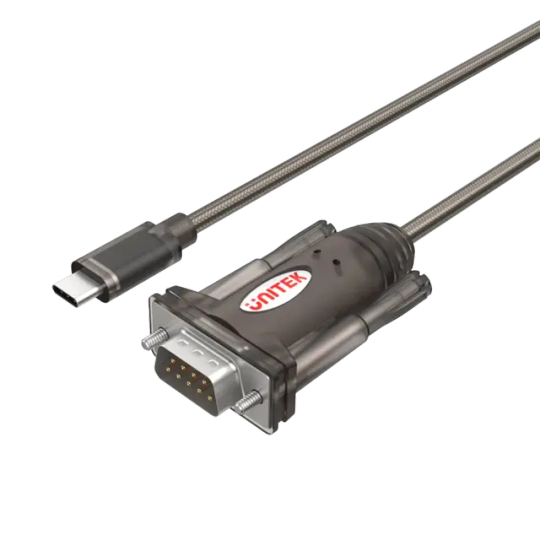
Unitek USB-C to Serial RS232 Cable UNITEK offers you the industry-use serial adapter with different connectors including this USB-C equipped adapter as well as USB-A equipped, and also RS232 and DB25M serial connector, to meet your needs Model Number: Y-1105K Product Overview: USB-C upstream connector Compatible with label writer, ISDN terminal adapter, printer Product Features: Support the conversion of USB-C to RS232. Link PC to Serial devices such as printer, label writer, ISDN terminal adapter. With USB specification v1.1. Flexible baud rate support up to 1.2Mbps. Bus powered, no external power supply needed. Hardware & Dimension: Color: Transparent Dark Brown Cable Length: 1.5M Upstream: USB-C Male Downstream: RS232 Male Package Contents: 1 x USB-C to Serial Cable Adapter
#USB_ADAPTER#ELECTRONICS#CABLES_CONVERTERS#ADAPTER#CNV_USB_C_SER_1.5M_U#SERIAL_CABLE#SERIAL_RS232#UNITEK#USB_C#Y_1105K
0 notes
Note
I've also seen these on custom AV installations where a single large cable is used to run a number of different signals a decent distance, and then breaks out into a cable like this on either end. I've personally installed some that use a half inch thick cable terminating on both ends with a DB25 connector, and a breakout cable that has two RCA composite video, RCA mono audio, RJ45 PTZ camera control, RS232 terminating in a DB9. Here are some of the cable diagrams for those cables:

Cable T511 was 50 feet of 1/2" thick cable. It was a beast to run, and we'd usually have at least 2 of them.
Here's another cable diagram for another of the cables that came in the kit:

For those interested in learning more, this is from the Tandberg Educator MXP classroom video conferencing system. https://www.clarybusinessmachines.com/products/files/tandberg/tandberg_educator_mxp_user_manual.pdf
any idea what this cable is?
looks like 9-pin vga on one side then breaks out into 7 wires labeled composite? on the composite side, one red wire is labeled "Composite Sync Output", one blue is labeled "C/V Sync Output", one green is labeled "Y/H Sync Output", and the black wire is labeled "Composite Video Output". the cable itself has a tag that says "cable from splitter to monitor"
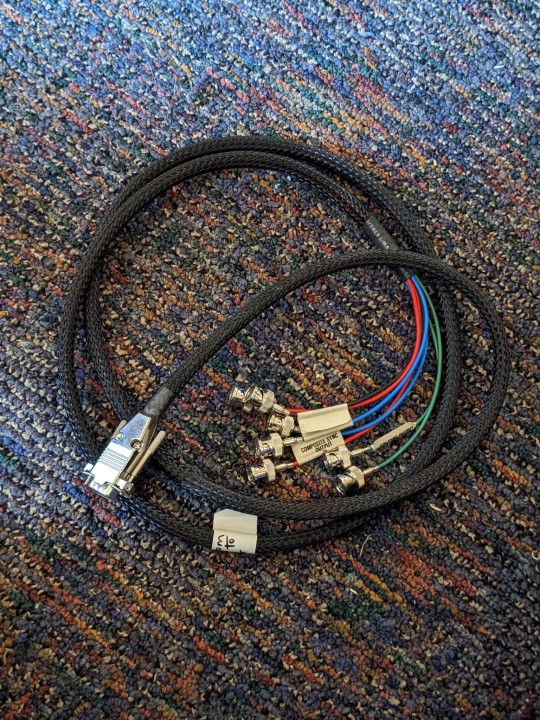

That's probably designed for some specialist video card that generates output for professional video production. That's why it's got separate syncs, because that's often needed to properly genlock all the stages.
No idea what specific card it is, or what device you'd plug it in, but this is the kind of cable that gets custom made for one specific card type and the next card will use a completely different cable, so both the cable and the card are useless when they get separated, as they inevitably do :(
104 notes
·
View notes
Text
5 Reasons Why The Zidoo Z9X Pro Realtek TV Box Is Best For (2023)
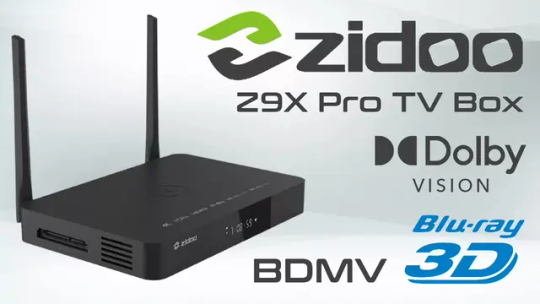
Exploring the Zidoo Z9X Pro: Detailed Review and First Impressions
Today I'm excited to dive into the unboxing and first impressions of the Zidoo Z9X Pro. As always, the anticipation of testing out a new TV box, especially one with unknown features, brings a sense of excitement. In this video, we'll explore the hardware and firmware features of the Z9X Pro, Zidoo's latest model running on an all-new Realtek chipset. Join me on this journey as we unbox and uncover the potential of this cutting-edge device.
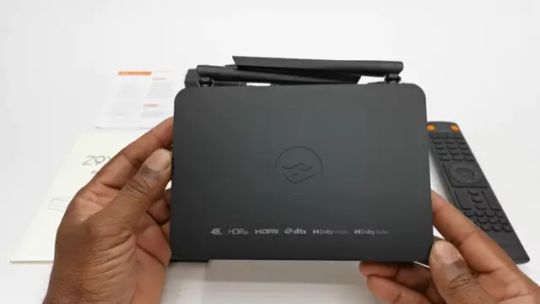
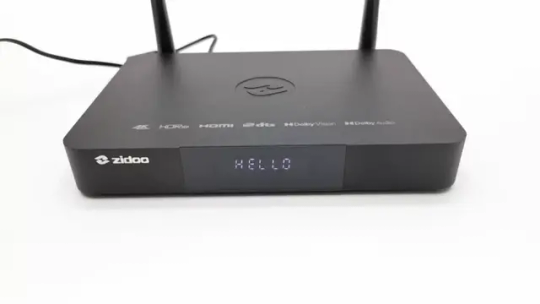
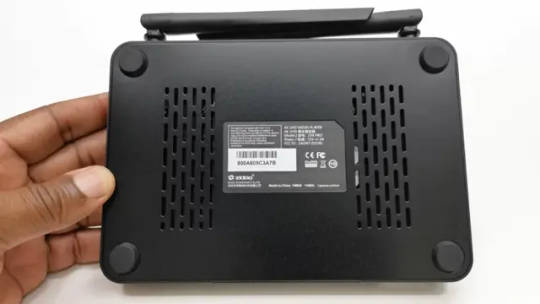
Unboxing the Zidoo Z9X Pro Let's start by looking at what's in the box of the Zidoo Z9X Pro and see what comes in the package. The standard TV box contents are there, but with an interesting addition: - Zidoo Z9X Pro Model: The star of the show, featuring an all-metal design with the Zidoo logo on top, boasting 4K display, Blu-ray BDMV, HDR10+, DTS audio, Dolby Vision, and Dolby audio. - Infrared Remote: Equipped with IR learning and backlit keys for convenient control. - HDMI Cable: A crucial accessory for connecting the TV box to your display. - Power Adapter: A 12V 2A 24W power adapter to keep the Z9X Pro powered up. - SATA Cable: Highlighting one of the exciting features, the inclusion of a SATA cable for expandable storage. - User Manuals: Comprehensive guides for both the TV box and remote, ensuring you make the most of its features. Now that we've unboxed the Z9X Pro, let's delve into its design and connectivity options.
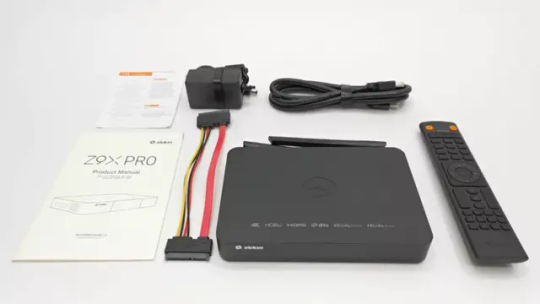
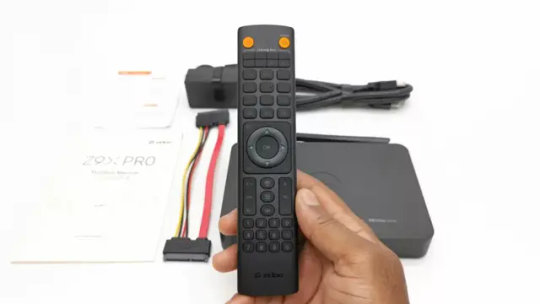
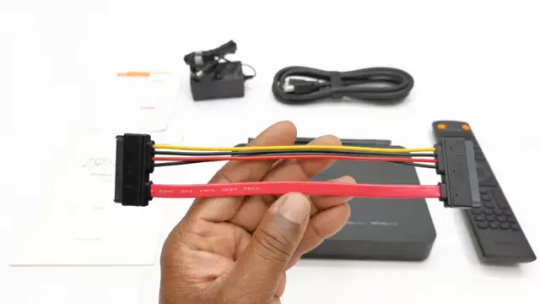
Zidoo Z9X Pro Design and Connectivity The Zidoo Z9X Pro boasts a sleek all-metal design consistent with the manufacturer's style. Let's take a closer look at its physical features: - Front: The top features the Zidoo logo and essential information about its display capabilities. - I/O Ports: The TV box is equipped with various ports, including HDMI 2.1, USB 3.0, gigabit LAN, optical audio, AV port, RS232, and DC power socket. - USB Ports: Two USB 2.0 ports and a reset button are conveniently placed on one side. - External SATA Connector: Positioned on the left side, the Z9X Pro surprises with an external SATA connector, catering to expandable storage needs. - Wi-Fi Connectivity: Enhanced with Wi-Fi 6, the Z9X Pro comes with a pair of Wi-Fi 6 antennas for improved wireless connectivity. - Base: The bottom features antiskid rubber feet for stability and ventilation holes to keep the device cool. Now, let's power up the Z9X Pro and explore its startup process and user interface.
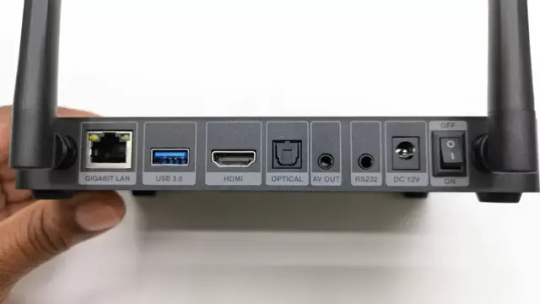
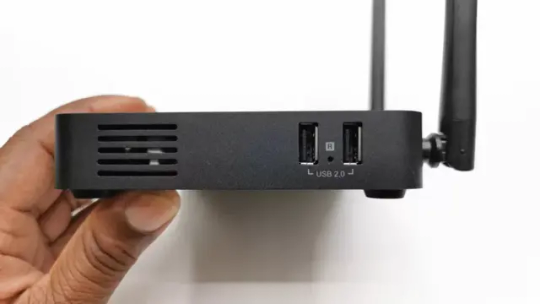
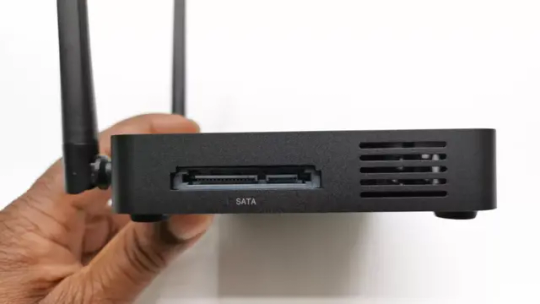
Initial Setup and User Interface The first bootup process introduces a Zidoo splash screen followed by a startup wizard, culminating in Zidoo's custom launcher. The ZIUI interface, specifically designed for navigation with a direction pad and OK button, presents a clean and intuitive layout. However, it's important to note that the unit received for review initially ran on ZIUI version 1.0.52, lacking Google Play Store and Play Services. To address this, an update to version 1.0.65G was necessary, ensuring seamless access to Google's ecosystem. The Zidoo team promptly addressed this, allowing users to enjoy the full suite of Google services.
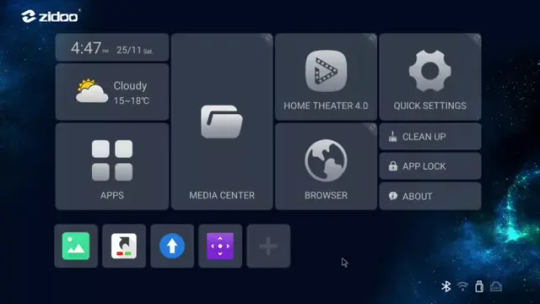
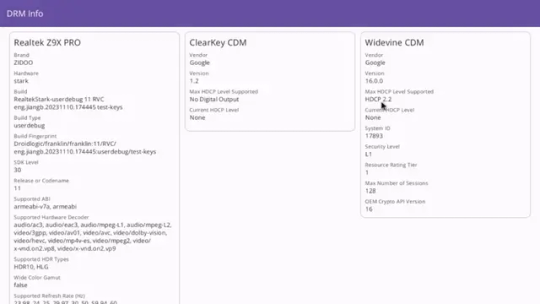
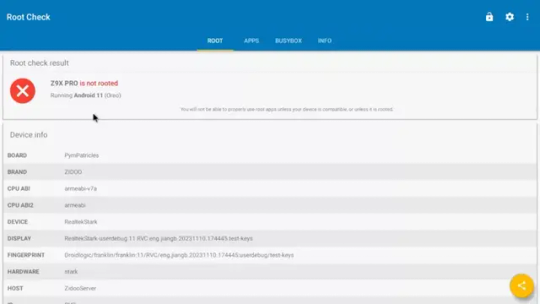
Zidoo Z9X Pro System and Hardware Information Let's delve into the heart of the Z9X Pro by examining its system and hardware specifications: - Chipset: The Z9X Pro breaks away from the traditional Amlogic, Rockchip, or Allwinner chipsets, opting for the Realtek RTD1619BPD. - Memory and Storage: With 4GB of DDR4 RAM and 32GB of internal storage, the Z9X Pro offers a robust configuration for smooth performance. - Bluetooth: Version 5.2 ensures enhanced connectivity options. - CPU: Powered by the Realtek RTD1619BPD, a quad-core cortex A55 processor clocked at 1.7 GHz in 32-bit mode. - GPU: The Mali G57 with Open GL ES version 3.2 handles graphics processing. - Wi-Fi: Wi-Fi 6 support provides improved wireless connectivity on both 2.4 and 5GHz bands. - Operating System: Running on Android 11, the Z9X Pro delivers the latest features and optimizations.
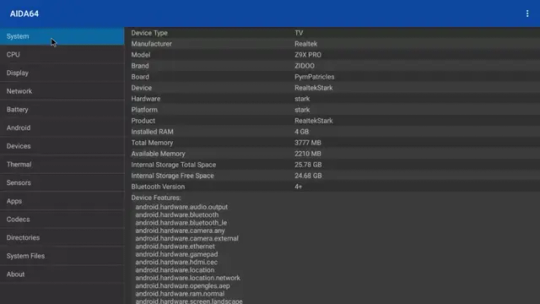
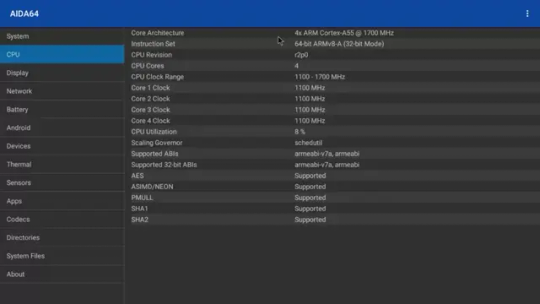
Advanced Video Playback Features The Zidoo Z9X Pro stands out with its advanced media player capabilities, especially in terms of video playback. Notable features include: - Blu-ray Playback: Setting it apart from conventional Android boxes, the Z9X Pro can play Blu-ray formats, offering a unique viewing experience. - Dolby Vision Compatibility: The TV box supports Dolby Vision, enhancing HDR capabilities. - Surround Sound Decoding: The Z9X Pro impresses with its ability to decode various surround sound formats, providing an immersive audio experience. - SATA Expandable Storage: The inclusion of an external SATA connector allows users to connect large legacy hard drives or modern SSDs for expanded storage options.
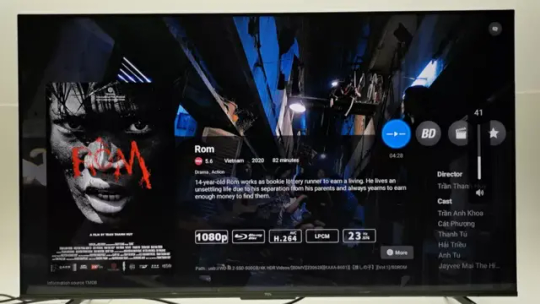
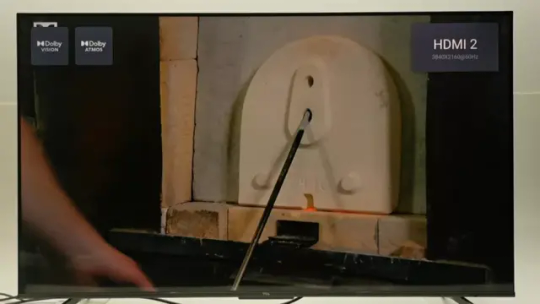
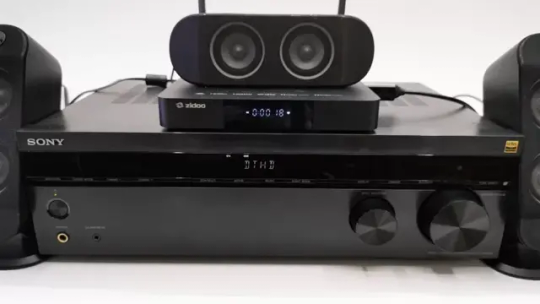
Benchmark Performance To gauge the Z9X Pro's performance, we conducted various benchmarks: - RAM and Internal Storage: The TV box demonstrated commendable speeds, ensuring smooth operations. - Wi-Fi and LAN Speeds: With Wi-Fi 6 support and a gigabit LAN port, the Z9X Pro showcased impressive network speeds. - Graphics Benchmark: While lacking Vulkan support, the Z9X Pro qualified for the slingshot test in the 3DMark graphics benchmark. - CPU Benchmark: In the Geekbench 5 CPU benchmark, the TV box scored well in both single-core and multicore tests. - Antutu Benchmark: Scoring 111,638 in the latest Antutu benchmark version 9, the Z9X Pro secured a competitive position. - View the Zidoo Z9X Pro ranking chart placement
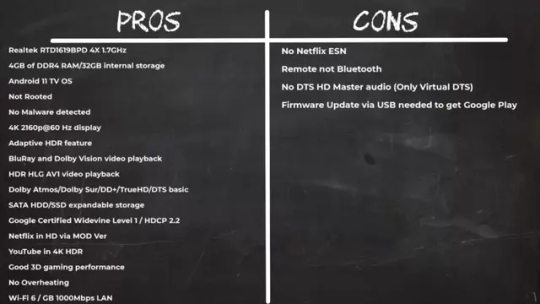
Final Thoughts on the Zidoo Z9X Pro In conclusion, the Zidoo Z9X Pro presents a promising addition to the TV box market. Its Realtek chipset, advanced video playback features, and robust specifications contribute to a compelling user experience. While it excels in many aspects, including Blu-ray playback and Dolby Vision support, a few limitations, such as the absence of Netflix ESN license and Vulkan GPU support, are worth noting. For those seeking a versatile media player with cutting-edge capabilities, especially in the realm of video playback, the Zidoo Z9X Pro proves to be a noteworthy choice. Read the full article
#Blu-rayTVBox#Zidoo#ZidooZ9XProbenchmarks#ZidooZ9XProDolbyAtmosDTSaudio#ZidooZ9XProDolbyVision#ZidooZ9XProfirmware#ZidooZ9XProGooglecertified#ZidooZ9XProhardwarespecs#ZidooZ9XProNetflixcertified#ZidooZ9XProNetflixinHD#ZidooZ9XProperformance#ZidooZ9XProprice#ZidooZ9XProprosandcons#ZidooZ9XProRealtekRTD1619#ZidooZ9XProreview#ZidooZ9XProrooted#ZidooZ9XProTVBox#ZidooZ9XProTVBoxStop
0 notes